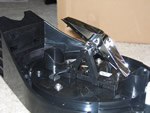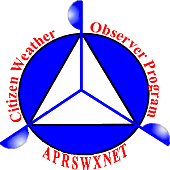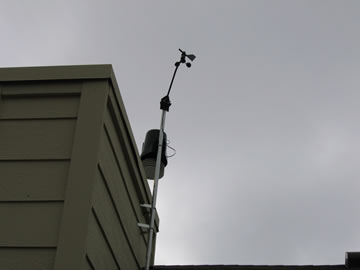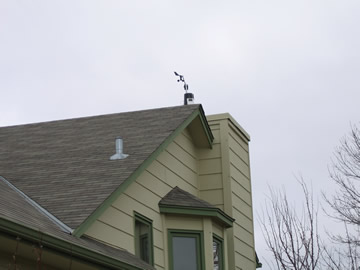About This Station
Our weather station is located in Lakeville, Minnesota, a southern suburb of Minneapolis/St. Paul, very close to the intersection of Cedar Avenue (Co. Rd. 23) and 170th Street. (Lat: N 44 ° 42 ' 3 '' Lon: W 93 ° 13 ' 15, Elevation: 1000 ft) Weather data comes to our website from a Davis Vantage Pro2 weather station. This is the most popular and highest rated private weather equipment in the world today. The data is collected every second and the website is updated every 5 minutes. The station is comprised of an anemometer, rain gauge and a thermo-hydro sensor. Our station is rooftop mounted, approximately 35 feet above ground level. The data is monitored, recorded, and published onto the internet via Weather Display software. The data also gets transmitted to several different weather networks, including Weather Underground (Station KMNLAKEV2), and the Citizen Weather Observer Program (Station CW5773). Quality Assurance data is provided by the CWOP program to lakevilleweather.com. Check our our accuracy here. |
Above is a view of the station from the Northeast Elevation. It is mounted on a standard 4.5 foot aerial mast. The station anemometer is on the very top of the mast, and includes a directional vane and wind cups. About 1.5 feet below is the ISS (Integrated Sensor Suite). The ISS contains a self-tipping rain gauge bucket that measures in 0.01" increments. Here is a closeup of the self-tipping device:
|
|
 |
The rain collects in and funnels through the bucket, and drips into the silver cups you see in the picture at left. Once the weight of the water tips the drip cup over, a magnet passes over a reed switch and sends a signal to the station. The water then drains out from the ISS. | |
Looking on the Southeast Elevation |
 |
|
About Lakeville, MinnesotaLakeville is located in the southeast corner of the Twin Cities metropolitan area, within Dakota County. Rich in historical lore, today's Lakeville had its origins back in 1853. That's when Captain William B. Dodd, who came from the east to serve the military forts in the Minnesota Territory, designed and directed the construction of a road that would serve as a practical land route connecting the military forts in St. Paul to the southern forts. The road, which was named for Captain Dodd after he was killed in the Sioux uprising in 1862, bisects present-day Lakeville. J.J. Brackett, who owned a St. Paul lumber mill and transported mail, supplies and travelers along this route, soon chose Lakeville as an ideal site for a town because it was roughly halfway between St. Paul and St. Peter. In 1855 he platted 250 acres and named it Lakeville because it bordered the nearby Prairie Lake. By 1858 Lakeville contained a general store, two hotels, a boarding house, a blacksmith shop, a saloon and a shoemaker shop. Griffin Phelps is believed to have been Lakeville's first real settler. He came to Minnesota in 1853 and went to work for J. J. Brackett. Mr. Phelps is believed to have "squatted" on land along Lake Marion before settlement was actually even legal. He is known to have sowed the first rye in the area in 1853, and was appointed postmaster in 1854 by President Pierce. The post office was the first in this part of the county, so people from Rosemount, Empire, Eureka and Poplar Grove came for their mail. Phelps served in the Civil War in Co. F, Hatch Battalion, Minnesota Cavalry, from 1864 to 1866, when he returned to Lakeville. Lakeville Township, which encompassed the rural area around the tiny town of Lakeville, was officially formed as a governing unit in 1858. A variety of ethnic groups settled in the Lakeville area in the early years, including immigrants from Ireland, Scotland, England and the Scandinavian countries. When the Hastings and Dakota Railroad was built near the tiny village of Lakeville in 1869, railroad officials tried to buy land for a depot from a Scotsman who refused to sell. The railroad then bought 20 acres a half mile east, put up a platform and named this area Fairfield. It wasn't long before existing businesses moved from the original town site to Fairfield, and new businesses were established at the new town site. For nine years, business owners and residents tried to get Fairfield's name changed to Lakeville. In 1878, they decided they wanted a government separate from the township and sought incorporation as the Village of Lakeville. The short-lived name of Fairfield is carried on in the city's Fairfield Business Campus and the Fairfield Apartments that provide housing for senior citizens. In 1910, Colonel Marion Savage and several partners had a dream that resulted in building an amusement park, along with a railroad line that connected the park with the Twin Cities. They located their park on the east shore of the then-Prairie Lake, renaming it Lake Marion after Colonel Savage. Antlers Amusement Park became one of the most famous amusement parks in the upper Midwest. It contained a lavish dance pavilion with a gleaming oak dance floor; a large bathing beach that featured a dock, diving tower and high sliding chute; a boat dock that offered sailboats, rowboats and canoes; a children's playground with a miniature operating train for children; tennis courts, an athletic field and baseball diamond with a grandstand for spectators; and an aerial swing. A nine-hole golf course was located nearby. The rail line was named the Dan Patch Railroad Line after the famous racehorse owned by Colonel Savage. Luxury excursion cars with real leather seats, stained glass upper windows and richly carved and inlaid wood brought thousands of visitors to the park each summer. On weekends in the summer of 1912, these trains reportedly made 19 scheduled runs each day. The area was already popular with wealthy families from southern states who came to escape summer heat and humidity. These families and other visitors stayed in cabins located around the lake or at Weichselbaum's Resort, which was famous for its fried chicken, apple pie and homemade ice cream. The amusement park declined in popularity in the 1920s and 1930s due to a combination of factors - the advent of the automobile, the Great Depression and several dry years that saw Lake Marion drop to its lowest level ever. The original village and fire hall, built in 1910, still stands downtown. Now home to small businesses and apartments, the building features a tower that once held a bell that summoned townspeople to fight fires. The original bell now hangs in a new tower on the Fire Department headquarters building. Agriculture was the major industry in Lakeville for many years, with several grain mills that handled crops grown by area farmers, and a creamery that processed milk into diary products. Airlake Industrial Park, which is now home to more than 100 businesses and employs 4,000 people, opened in 1967. At the same time, most of Lakeville Township merged with the Village of Lakeville to become the 38-square-mile City of Lakeville. Just prior to the merger, Lakeville Township included 2,100 residents, while the village was home to just under 1,000. By 1970, Lakeville's population had grown to 7,557. The population doubled from 1970 to 1980, and doubled again from 1980 to 1992. The current population is more than 43,000. Lakeville is expected to become the largest city in Dakota County by the year 2020. - From the Lakeville Historical Society |
||
| Status Page | ||
Copyright © 2006, lakevilleweather.com
| This site is powered by Weather
Display v10.37k software
This website is NOT an official source of weather to
use for aviation or other navigational planning decisions.



